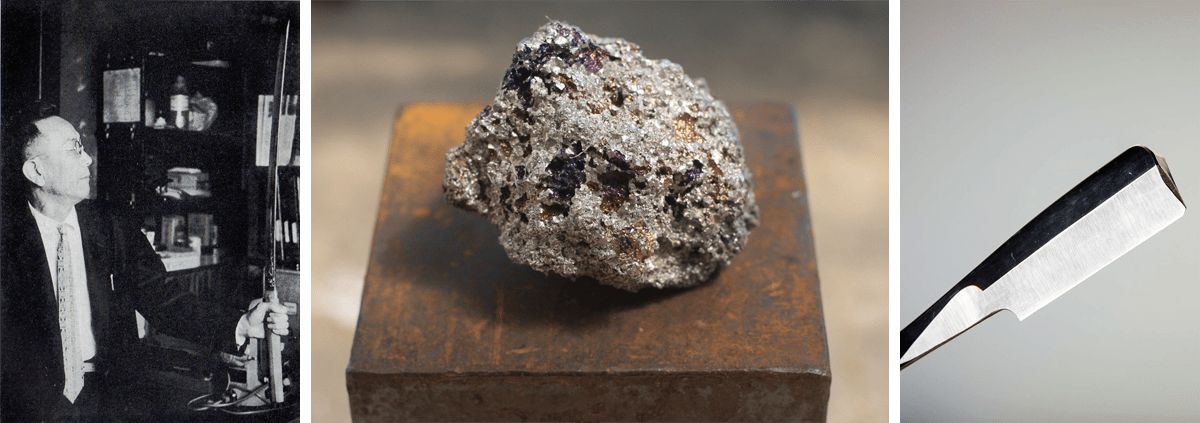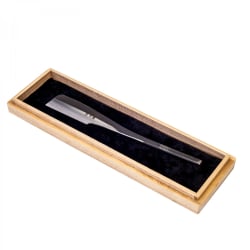Shaving's Sharp Master
Author: Fredrik Bengtsson
Masculinity and growing a beard have always gone hand in hand. It is perhaps why the razor brings out so many ambivalent feelings in men. What's more masculine than shaving off the beard with a steady hand and a sharp blade? Gents; take a look at Iwasaki Tamahagane Kamisori, the world's oldest razor, forged from the same steel as the legendary Samurai swords, and in accordance with the ancient Japanese traditions.

The razors have beautiful grips made of horn and exclusive woods. It's neither the material nor the decoration on the shaft that is most fascinating, but it is the blade's sharpness that matters the most. Anyone looking for the best quality of shaving razors will focus more on the blade - something the Tamahagane is renowned for. The best quality blades are usually forged of steel mined at Solingen in Germany, Sheffield in England, or from the mines in Northern Sweden also referred to as "Swedish steel". The steel from these areas has its history and is renowned for its individual and unique advantages. As much as enthusiasts might differ, they all agree on one thing - the region that's responsible for the best blades is Japan! The steel that makes the Japanese Samurai's Katana is the most impressive of them all in terms of superior craftsmanship, durability and sharpness.
The Samurai long sword, the Katana, was made of Tamahagane steel, extracted from sand. In its crude form, it is of low-quality steel and contains many impurities. The steel is created in a long and laborious process, whereby the iron powder is added to carbon steel every ten minutes, for between 36 hours to 72 hours. The Japanese swordsmiths employed the technique of damasking the steel, where they heated and hammered the steel until it stretched.It was then folded in a process that was repeated 16 times. Each time, more and more impurities were driven out and its quality improved. The thickness increased until, eventually, the sword consisted of 65,536 layers of steel.
 Kousuke Iwasaki / tamahagane steel / Iwasaki Tamahagane 2chogake
Kousuke Iwasaki / tamahagane steel / Iwasaki Tamahagane 2chogake
During the manufacturing process, the swordsmith had to maintain a balance between sharpness and strength. It is an essential factor to consider during curing, which is a repeat process where the steel is first heated and then cooled down. Hard steel becomes warmer faster but is, at the same time, fragile. Softer steel which is older becomes more resistant, plus it stays sharper for a long time. In the Western world, the swordsmiths chose a different method; they created steel swords that were quite durable but of very poor quality. At the same time, the Japanese smiths had perfected the craft, unlike their European counterparts, because they used pure steel. They refused to compromise and instead, developed a technique where they heated the steel. They then covered the blade with different thick layers of insulating clay paste. After this, they cooled it with water - a process that made the edge cool fast and harden, while the tip became softer and more durable. The final product is what made the Japanese smiths become recognised as the masters of metallurgy.
Creating the Tamahagane is an attempt to emulate the craftsmanship and Samurai values. Forged from the same steel as the legendary Samurai swords, it goes through a rigorous process to create the ultimate razor blade. Manufactured in the Sanjyo Seisakujo factory, the process isn't as complicated and difficult nowadays as it was back then. However, only half of the trials lead to a finished blade. Any blade that passes through all the steps in this complicated manufacturing process is eventually stamped, to signify its approval as a masterpiece of artisan craftsmanship.
Iwasaki's founder Kousuke Iwasaki dedicated his life to the Japanese national treasures. He decided to master the production of Tamahagane, and left Tokyo University with dual degrees in both literature and metallurgy, to become an apprentice. After finally earning the title of a master swordsmith, Kousuke then started forging his own blades. He developed the Tamahagane razor, which is now regarded as an extremely rare and valuable piece of Japanese history. He passed on his knowledge, first to his son Shigeyoshi Iwasaki, and then to Ryuichi Mizuochi, who today is in charge of the Tamahagane blade's production. It is an example of how the Japanese traditions and knowledge are passed on and preserved.
The Iwasaki Tamahagane Kamisori has now become a famous razor across the world. With its rough surface and unpolished exterior, it is something that helps men radiate self-esteem. It's not the most expensive razor, but there is no doubt that it is the most exclusive and sought-after razor blade.

